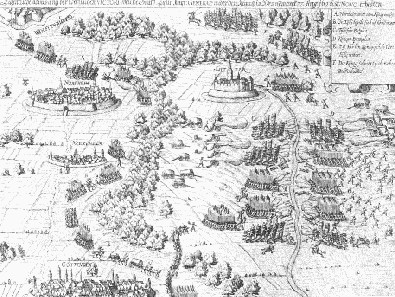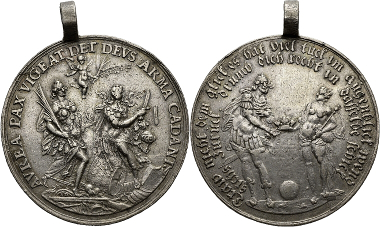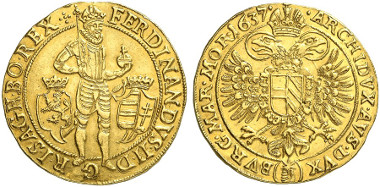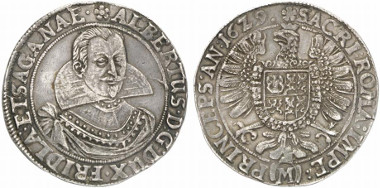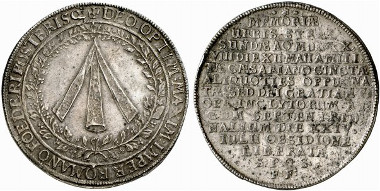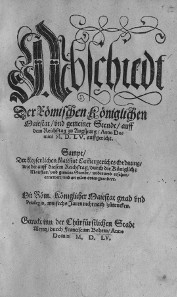translated by Annika Backe
After Denmark had become involved, too, four individual armies marched through the northern part of Germany in spring 1626: on the Protestant side there was Christian of Denmark and Mansfeld whose army had pillaged East Friesland in order to survive and was now remunerated by England; on the Catholic side there was the army under the command of Tilly, which the League had provided the emperor with, and the imperial army that had been levied by Wallenstein.
Both sides, Christian of Denmark and Mansfeld as well as Tilly and Wallenstein, were more concerned with fighting for the leadership of the campaign than with planning a joint operation. That was why the armies were not being united.
Mansfeld, who intended to evade the Diocese of Magdeburg and hence crossed the Elbe River, was inflicted such heavy losses by Wallenstein that he was forced to retreat immediately to the Margraviate of Brandenburg. His next actions seem a bit confused. Heading towards Silesia at first, he had such big a quarrel with his proxy that a joint approach was no longer impossible. With destination unknown Mansfeld and his army then headed for the Dalmatian coast. During that trip he died, at some place not far from Sarajevo. What he left behind was an army consisting of ill-disciplined, impoverished and hungry soldiers who marched through the land, pillaging and trying to survive.
Contemporary drawing of the Battle of Lutter, 17th century. Source: Wikicommons.
In the meantime, Tilly had confronted the army of Christian of Denmark near Lutter. The experienced military commander of the League prevailed in that battle. The Dane not only lost half of his army but – and that was much more difficult to replenish – his entire artillery.
Saxony. John George I, 1611-1656. Medal n. y. (1627) of Sebastian Dadler on the hope for peace after the Battle of Lutter. Peus 413 (2014), 1871.
Emperor Ferdinand II had thus assured his strong position at the beginning of 1627. The army of Mansfeld had been neutralized by the death of its commander while the Danish army had been weakened to such an extent that it would not have posed a threat for quite some time and Wallenstein, by order of the emperor, had gathered 14,000 men under his flags.
Although, during a meeting in Würzburg in January 1627, the League demanded to curb the power of Wallenstein, Ferdinand did not feel compelled to do so. His commander had just informed him during a personal get-together in Prague that the resources of the countries he occupied alone would suffice to fund the war for six years and that he could thus expand the power of the emperor northwards.
Bohemia. Ferdinand II. 10 ducats, 1637, Prag. Auction sale Künker 239 (2013), 5652.
These were tempting ideas. Ferdinand had pushed through only very recently that the Bohemian crown was no longer elective but became hereditary. Why not assert his power likewise in the north, with the help of the 140,000 soldiers of Wallenstein? To facilitate the work of his commander, the emperor appointed his loyal servant Duke of Mecklenburg.
Albrecht of Wallenstein, 1623-1634. Reichsthaler 1629, Wismar. Auction sale Künker 201 (2012), 787.
The reasoning of Ferdinand ran along such lines as: by supporting Christian of Denmark, the former holder of this office had proven himself unworthy of his territories. That was as much a breach of the imperial constitution as the transfer of the electoral dignity to Maximilian, but Maximilian after all belonged to the oldest and most important dynasties of the empire. Someone like Wallenstein, on the other hand, was a creature of the emperor. What would this lead to, wondered the German electors during their meeting in Mühlhausen, when the emperor took the liberty to command the noble men of the empire just as he liked?
It seemed that Ferdinand had gone too far that time. The electors openly threatened the emperor to not elect his son as successor as long as Wallenstein remained in supreme command of the imperial army.
Ferdinand was far too clever to dismiss of such a useful tool as Wallenstein without negotiating some advantages in turn. Most of all, he needed his military commander to carry out his North Sea-Baltic Sea policy. Wallenstein was to get control over the most important Hanseatic cities because Hamburg and Lübeck had refused to make a pact with the emperor of their own accord.
Stralsund. Broad 1 1/2 reichsthaler 1628 on the lifting of the imperial siege laid on the city of Stralsund on July 24, 1628. From Künker 145 (2008), 7024.
Wallenstein’s first target was Stralsund. The city fathers soon realized that they did not stand a chance against the huge imperial army all alone. So they decided to make a pact with Gustavus Adolphus and granted him the right of use of the Stralsund port for a period of 30 years in return for his protection of the city. Being aided by the Swedish, Stralsund resisted the siege laid by Wallenstein. On July 28, 1628, Wallenstein was forced to retreat because Christian of Denmark had landed south-east of Stralsund, accompanied by a fresh army, had raided Wolgast and was about to attack Mecklenburg.
September 2, 1628, was the date when Wallenstein and Christian met in battle. The second defeat of the Danish king was so devastating that he fled to Denmark and begged for peace from there.
That made Ferdinand the unchallenged ruler in the Holy Roman Empire – once again. Since the massive military machinery of Wallenstein had crushed the last Protestant army, the emperor could forcefully push through everything he wanted.
Historian love to add a “would have” and an “if” every now and then and that is what we would like to do as well. If Ferdinand had only been interested in the power of his house there would have been no better opportunity to consolidate that position of power by compelling all quarreling parties to agree to a peace that was very convenient for him. But Ferdinand was not only a power politician. He saw himself first and foremost as a fighter for the Catholic faith. He therefore could not bear what was happening in the aftermath of the Peace of Augsburg in 1555.
Front page of the Peace of Augsburg by Franz von Behem, printed in Mainz in 1555. Source: Wikicommons.
Back then, the parties had agreed that the ruler was entitled to determine the religion of their subjects within the domains they controlled. Under the phrase “who rules, his religion” (which had been coined earlier, by the way) more and more princes had converted to Lutheranism that offered not only the more convincing beliefs but also the opportunity to seize churchly possessions and add them to the princely domains.
Ferdinand was willing to ensure those people tolerance which had been Protestants at the time of the Peace of Augsburg. All churchly possessions that had been secularized after 1555, however, were to be returned to the church. That, however, would have resulted in a massive transfer of property in the empire.
Since Ferdinand realized that his edict would not obtain a majority in the imperial diet he decided to enact that law by decree and to enforce its implementation by the help of Wallenstein’s 140,000 soldiers.
The Edict of Restitution, 1629. Source: Wikicommons.
The Edict of Restitution passed on March 6, 1629. It comprised three major elements: firstly, it deprived the Calvinists of their right to exist; secondly, no Protestant was allowed to acquire churchly land anymore; thirdly, all former verdicts on churchly estates were declared null and void. That made the emperor the board of arbitration for all those matters he wanted to seize himself.
Magdeburg. 12 groschen, 1629. Coinage struck during the siege. Auction sale Künker 237 (2013), 2298.
The city of Magdeburg was chosen in order to illustrate that the emperor was able and willing to implement that edict. At the time of the Augsburg Confession, Magdeburg had been Catholic but now accommodated more Protestants than Catholics. Magdeburg was ideally suited, being strategically very important.
In the next episode you can read about which event interfered with Ferdinand’s advance towards Magdeburg.



